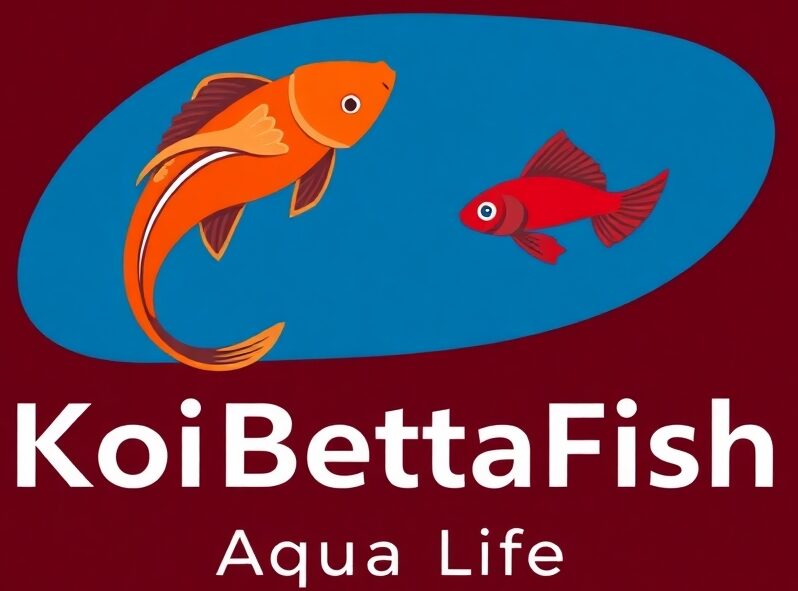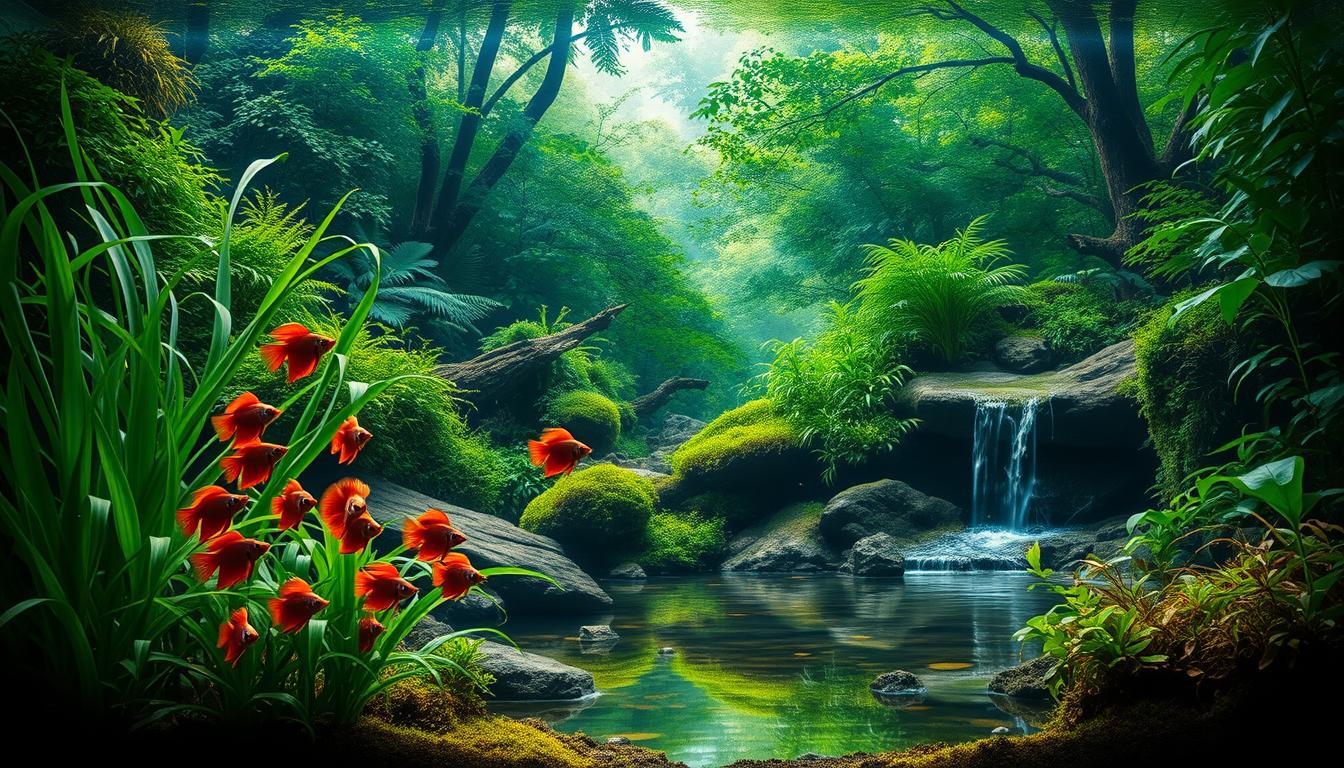Setting up a betta fish natural habitat tank is one of the best things you can do for your pet’s health and happiness. In the wild, bettas thrive in shallow, warm, slow-moving waters filled with plants and hiding spots. When creating a betta fish natural habitat tank, it’s important to mimic these conditions as closely as possible.
This includes the right water temperature, gentle filtration, and natural decorations like live plants and driftwood. In this guide, you’ll learn how to build a betta fish natural habitat tank that looks great and makes your fish feel right at home.
Key Takeaways
- Understand the natural habitat of betta to recreate it.
- Learn how to create a thriving environment for your betta.
- Get tips on betta fish care to keep your pet healthy.
- Discover the importance of mimicking wild conditions for your betta.
- Find out how to make your betta’s tank a happy home.
Understanding the Wild Habitat of Betta Fish
To create a thriving environment for your Betta fish, it’s essential to understand their natural habitat. Betta fish are native to the warm, shallow waters of Southeast Asia, where they thrive in environments rich with vegetation and hiding spots.
The Rice Paddies and Shallow Waters of Southeast Asia
In their natural habitat, Betta fish inhabit rice paddies, slow-moving streams, and shallow waters. These environments are characterized by soft, slightly acidic water and an abundance of plants that provide shelter and food. The water conditions in these areas are often gentle, with minimal current, allowing Betta fish to thrive.
- Warm water temperatures
- Abundant vegetation
- Soft, slightly acidic water conditions
Seasonal Changes in Betta’s Native Environment
Seasonal changes bring fluctuations in water levels and temperature, to which Betta fish have adapted over time. During the dry season, water levels decrease, and Betta fish must adapt to survive in smaller, more confined spaces. In contrast, the wet season brings an influx of water, replenishing their habitats and providing new areas to explore.
By understanding these natural conditions, you can better replicate their environment in your Betta fish tank setup, ensuring your Betta fish lead a happy and healthy life. This includes meeting specific Betta fish tank requirements such as appropriate water temperature, pH levels, and providing ample hiding spots and plants.
Why Recreating a Natural Betta Fish Habitat Matters
Why bother recreating a natural betta fish habitat? The answer lies in the benefits it brings to your betta’s life! By mimicking their natural environment, we can significantly improve our betta’s overall well-being.
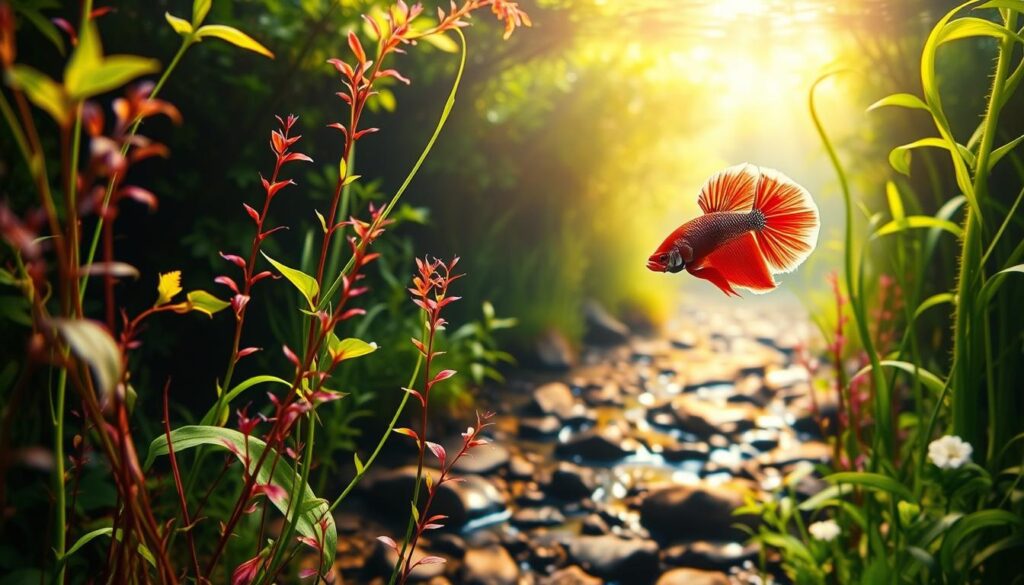
Health Benefits for Your Betta
A natural betta fish habitat isn’t just about aesthetics; it’s about creating a healthy environment for your pet! Studies have shown that betta fish kept in naturalistic settings tend to have stronger immune systems and reduced stress levels. “A well-designed tank can be the difference between a thriving betta and one that’s just surviving,” says a renowned aquarist. By providing a spacious tank with adequate hiding spots and plants, we can encourage our betta to thrive.
Behavioral Improvements in a Natural Setting
In a natural setting, betta fish exhibit fascinating behaviors that are often suppressed in bare tanks. With plenty of hiding spots and plants, your betta will feel secure enough to explore, play, and even display their natural courtship behaviors! As we recreate their natural habitat, we’re not just improving their living conditions – we’re giving them a chance to be their amazing selves.
Essential Betta Fish Tank Requirements
The right tank conditions can make all the difference in your Betta’s life, so let’s dive into the essentials! When setting up a home for your Betta, there are several key factors to consider to ensure they thrive.
Minimum Tank Size for a Healthy Betta
First and foremost, tank size matters! A minimum tank size of 5 gallons is recommended for Betta fish. This size provides your Betta with enough space to swim and helps stabilize water parameters, reducing the risk of sudden changes that can stress your fish. A larger tank also gives you more flexibility in terms of decoration and the addition of other aquatic elements.
Water Parameters: Temperature, pH, and Hardness
Betta fish are tropical, so they thrive in warm water. The ideal temperature range for a Betta tank is between 76-82°F (24-28°C). In terms of pH, Betta fish prefer slightly acidic water, with a pH range of 6.5-7.5 being ideal. Water hardness should be moderate, with a dGH of 5-20. Maintaining these parameters will help keep your Betta healthy and happy.
| Parameter | Ideal Range |
|---|---|
| Temperature | 76-82°F |
| pH | 6.5-7.5 |
| Water Hardness (dGH) | 5-20 |
Filtration Needs That Mimic Natural Water Flow
Filtration is crucial for maintaining clean and healthy water. However, Betta fish prefer gentle water flow. A good rule of thumb is to choose a filter that provides a gentle current, mimicking the slow-moving waters of their natural habitat. This will help keep your Betta comfortable and stress-free.
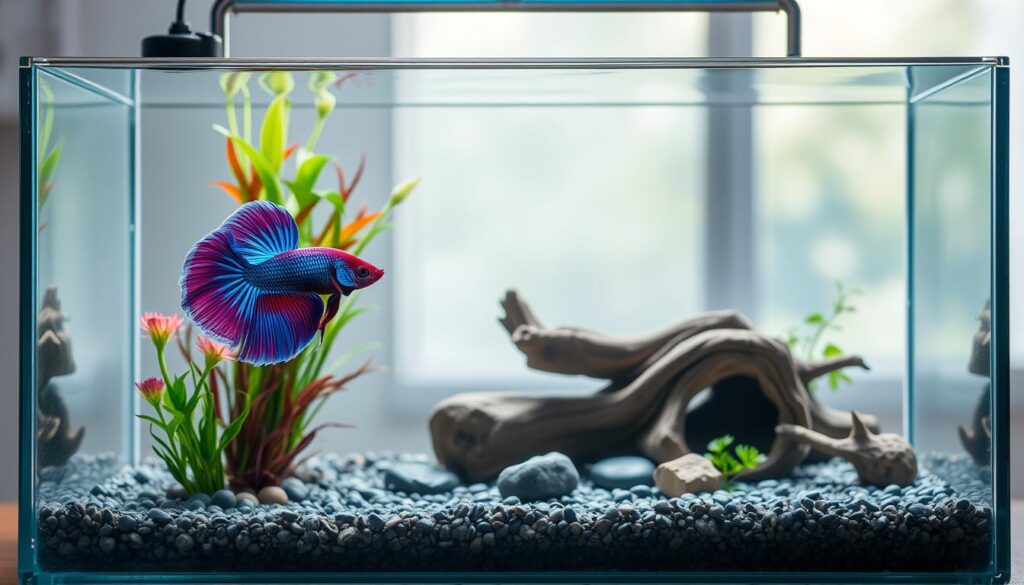
By focusing on these essential tank requirements, you’ll be well on your way to creating a happy and healthy home for your Betta fish. Remember, a happy Betta is a thriving Betta!
Setting Up Your Betta Fish Natural Habitat Tank
Creating a thriving environment for your betta fish starts with the right tank setup. You’re about to embark on a fun journey to recreate their natural habitat, and we’re here to guide you every fin-ful step of the way!
Choosing the Right Tank Shape and Design
When it comes to selecting a tank for your betta, the shape and design matter. You want a tank that’s long and wide enough for your betta to swim comfortably. A minimum tank size of 5 gallons is recommended, but the bigger, the better! Consider a tank with a wide mouth to provide ample surface area for oxygen exchange.
Some popular tank shapes for betta fish include:
- Long, rectangular tanks that provide plenty of swimming space
- Wide, shallow tanks that mimic the natural environment of betta fish
- Tanks with built-in dividers or compartments to create separate zones
Substrate Options That Reflect Their Natural Environment
The substrate you choose can make or break the natural ambiance of your betta’s tank. You want something that mimics their native environment, such as the soft, sandy bottoms of rice paddies and slow-moving streams. Here are some substrate options to consider:
| Substrate Type | Description | Benefits |
|---|---|---|
| Fine Gravel | Small, rounded stones | Gentle on betta fins, easy to clean |
| Play Sand | Soft, fine-grained sand | Mimics natural environment, comfortable for betta to rest on |
| Seachem Fluorite | Nutrient-rich, clay-based substrate | Promotes healthy plant growth, natural look |
Creating Zones: Open Swimming Areas and Hiding Spots
Betta fish love to swim, but they also appreciate having places to hide and feel secure. To create a natural environment, you’ll want to strike a balance between open swimming areas and hiding spots. You can achieve this by incorporating plants, rocks, and driftwood into your tank design.
Consider adding:
- Floating plants like water wisteria or java moss to provide shade and security
- Rocks or stone formations to create hiding spots and visual interest
- Driftwood or other decorations to create caves and crevices
By creating a natural, welcoming environment, you’ll be helping your betta thrive. And don’t forget to have fun with it – decorating a tank is a creative process, and you can’t go wrong with a little experimentation!
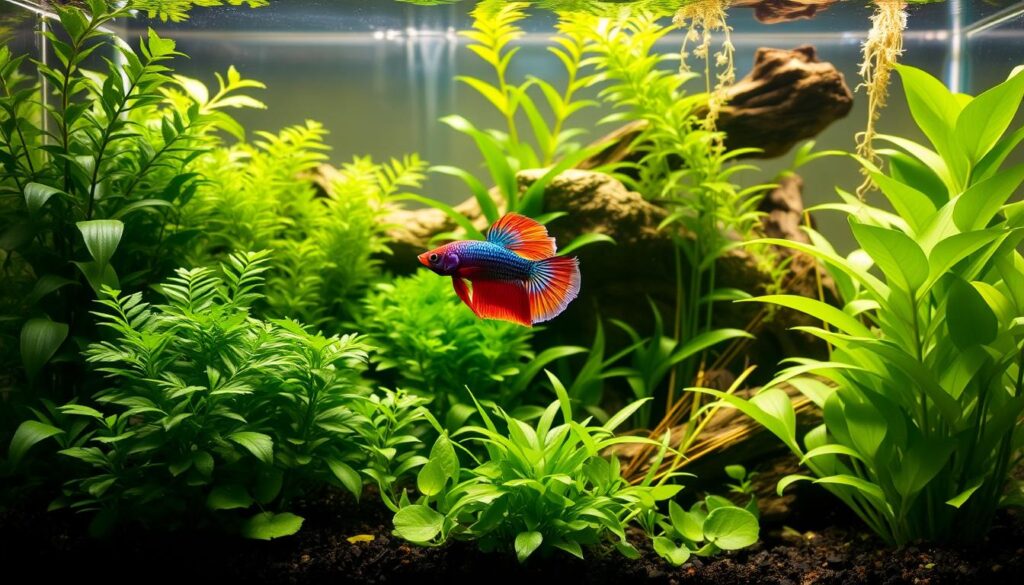
Best Plants for a Betta Fish Natural Habitat
Plants are not just a decorative addition to your Betta tank; they’re essential for creating a healthy, thriving environment. By incorporating the right plants into your Betta fish natural habitat, you’ll not only enhance the aesthetic appeal of the tank but also improve your Betta’s quality of life.
Floating Plants That Provide Shade and Security
Floating plants are a great addition to any Betta tank. They provide shade, reduce algae growth, and create a sense of security for your Betta. Some excellent options include Water Wisteria and Duckweed. These plants float on the surface of the water, creating a natural canopy that your Betta can swim under and hide within.
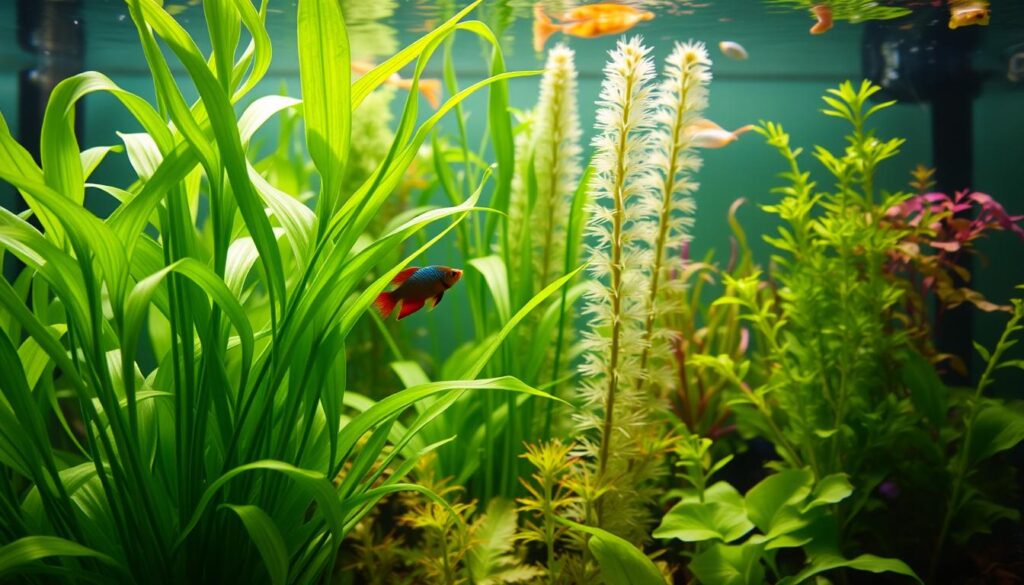
Root-Based Plants for Exploration and Rest
Root-based plants offer your Betta places to explore and rest. Plants like Java Ferns and Anubias have robust root systems that can be attached to rocks or driftwood, providing your Betta with hiding spots and areas to rest. These plants also add visual interest to your tank, creating a more natural environment.
Easy-to-Maintain Plant Species for Beginners
If you’re new to planted tanks, you’ll want to start with easy-to-maintain plants. Java Moss and Cabomba are excellent choices for beginners. They’re hardy, easy to care for, and can thrive in a variety of conditions. These plants are perfect for creating a lush, natural environment in your Betta tank without requiring extensive care.
| Plant Type | Benefits | Care Level |
|---|---|---|
| Water Wisteria | Provides shade, reduces algae growth | Moderate |
| Java Fern | Offers hiding spots, visual interest | Easy |
| Java Moss | Easy to maintain, creates lush environment | Easy |
By choosing the right plants for your Betta tank, you’ll be able to create a natural habitat that supports your fish’s health and well-being. Whether you’re a seasoned aquarist or just starting out, incorporating plants into your tank is a great way to enhance your Betta’s environment.
Natural Decorations for Your Betta Tank
Recreating a betta fish’s natural habitat is not just about the tank’s size or the water’s quality; it’s also about the decorations that make your betta feel at home. Natural decorations can transform your betta tank into a thriving ecosystem that mimics the wild. In this section, we’ll explore some of the best natural decorations you can use to create a happy and healthy environment for your betta.
Driftwood: Benefits and Placement Tips
Driftwood is a fantastic addition to any betta tank. Not only does it provide hiding spots and visual interest, but it also helps to create a natural environment. When choosing driftwood, make sure it’s safe for aquarium use and free of any sharp edges that could harm your betta. Placement is key; position the driftwood in a way that creates separate areas for your betta to explore and hide.
Benefits of Driftwood:
- Provides hiding spots and reduces stress
- Creates a natural environment
- Can help to stabilize water parameters
Rocks and Stones: Creating Natural Structures
Rocks and stones are another great way to enhance your betta tank’s natural beauty. They can be used to create structures that mimic the betta’s native waters, such as rocky crevices or gravel beds. When selecting rocks and stones, ensure they are aquarium-safe and won’t affect the water chemistry.
| Type of Rock/Stones | Benefits |
|---|---|
| River Rocks | Creates natural hiding spots, adds visual interest |
| Gravel | Easy to clean, provides a natural substrate |
Leaf Litter: Recreating the Forest Floor Effect
Leaf litter is a simple yet effective way to recreate the forest floor effect in your betta tank. It provides a natural food source for beneficial bacteria and can help to create a more balanced ecosystem. Choose leaves that are safe for aquarium use, such as almond leaves or oak leaves, and avoid using leaves that have been treated with pesticides.
Tips for Using Leaf Litter:
- Rinse the leaves before adding them to the tank
- Start with a small amount and monitor the tank’s response
- Replace the leaves regularly to maintain water quality
Lighting and Temperature in a Betta Fish Natural Habitat Tank
When setting up a betta fish tank, it’s crucial to consider the lighting and temperature to recreate their natural habitat. Betta fish originate from the warm, tropical waters of Southeast Asia, where they are exposed to specific light cycles and temperatures that influence their behavior, health, and overall well-being.
Natural Light Cycles and Their Importance
In their natural habitat, betta fish experience a regular day-night cycle that regulates their circadian rhythms. To mimic this in your tank, you should maintain a consistent lighting schedule. This not only helps your betta feel secure but also promotes healthy activity patterns. A 12-hour light-dark cycle is recommended, which can be achieved using a timer for your tank lights.
Best Lighting Options for Plant Growth and Betta Health
For a thriving betta habitat, the right lighting is crucial. LED lights are a popular choice because they are energy-efficient and produce minimal heat, which can help maintain a stable water temperature. When choosing lighting, consider the needs of any plants you’re growing in your tank, as well as the comfort of your betta. Some plants require more light to photosynthesize effectively, while betta fish prefer subdued lighting to reduce stress.
Maintaining Optimal Temperature Ranges
Betta fish are tropical and prefer warmer waters. The ideal temperature range for a betta fish tank is between 76°F and 82°F (24°C to 28°C). Maintaining this temperature range is vital for your betta’s health, as it supports their metabolism and immune system. Using a reliable aquarium heater and thermometer can help you keep the water temperature consistent, even in cooler environments.
| Temperature Range (°F) | Temperature Range (°C) | Health Impact on Betta |
|---|---|---|
| 76-82 | 24-28 | Optimal for health and metabolism |
| Below 76 | Below 24 | Can lead to lethargy and disease susceptibility |
| Above 82 | Above 28 | Can cause stress and reduce oxygen levels |
Feeding Your Betta in a Natural Habitat Setup
A natural habitat setup for betta fish isn’t just about the environment; it’s also about the food they eat! To keep your betta thriving, you need to understand their natural feeding behaviors and provide a diet that mimics their wild diet.
Natural Feeding Behaviors of Wild Bettas
In their natural habitat, betta fish feed on small insects, plankton, and even tiny crustaceans. They are carnivorous, and their diet consists mainly of protein-rich foods. “Betta fish are opportunistic feeders,” meaning they eat when they can, and their diet varies depending on what’s available in their environment. To replicate this in your tank, you can offer live or frozen foods like brine shrimp or bloodworms, which will stimulate their natural hunting instincts.
Best Food Options to Support Health in a Natural Tank
While commercial betta pellets or flakes can be a staple, it’s essential to supplement with live or frozen foods to promote health and vitality. You can also try offering daphnia or mosquito larvae to add variety to their diet. A diverse diet will not only keep your betta healthy but also encourage natural behaviors, making your tank more engaging to watch. As a betta fish care guide recommends, varying their diet is key to their overall well-being.
Compatible Tank Mates for a Natural Betta Community
Betta fish can live with other peaceful species, and we’re here to guide you through the process of creating a harmonious community tank! While betta fish are often kept alone, they can thrive in a well-planned community setting with the right tank mates.
Species That Coexist with Bettas in the Wild
In their natural habitat, betta fish coexist with various species that share similar water requirements. Some compatible tank mates include:
- Neon tetras – These small, schooling fish are very active and add a lot of movement to the tank.
- Harlequin rasboras – Peaceful and colorful, they can add a nice contrast to your betta’s bright colors.
- Corydoras catfish – Good for cleaning up food debris from the substrate, they’re a great addition to a community tank.
When choosing tank mates, it’s crucial to select peaceful, non-fin-nipping species that won’t harass your betta.
Creating a Balanced Community Tank
Creating a balanced community tank involves more than just choosing the right species. You need to ensure that your tank is large enough and well-planted to provide plenty of hiding spots. A minimum tank size of 20 gallons is recommended for a community setup, as it gives you the flexibility to create different zones within the tank.
Some key considerations include:
- Providing plenty of plants and decorations to create hiding spots and reduce aggression.
- Ensuring that the tank is not overcrowded, as this can lead to stress and disease.
- Monitoring water parameters closely, as different species may have slightly different requirements.
With careful planning and attention to detail, you can enjoy a vibrant, diverse community tank that showcases the beauty of your betta and its tank mates!
Conclusion: The Rewards of a Natural Betta Habitat
Creating a natural betta habitat is a rewarding experience that not only enhances the beauty of your tank but also significantly improves your betta’s quality of life. By understanding and replicating the conditions of their wild habitat, you can provide your betta fish with a healthy, thriving environment.
We’ve explored the essential elements of a betta fish natural habitat tank, from choosing the right tank and plants to selecting compatible tank mates. Our betta fish care guide has walked you through the process of recreating a natural environment that promotes health and well-being.
By following these guidelines, you‘ll be able to create a stunning and natural home for your betta fish. So, get creative and have fun designing your betta’s dream home – we can’t wait to hear about your experiences!
Read Also How Many Betta Fish in a 10 Gallon Tank? Tips You Need to Know!
